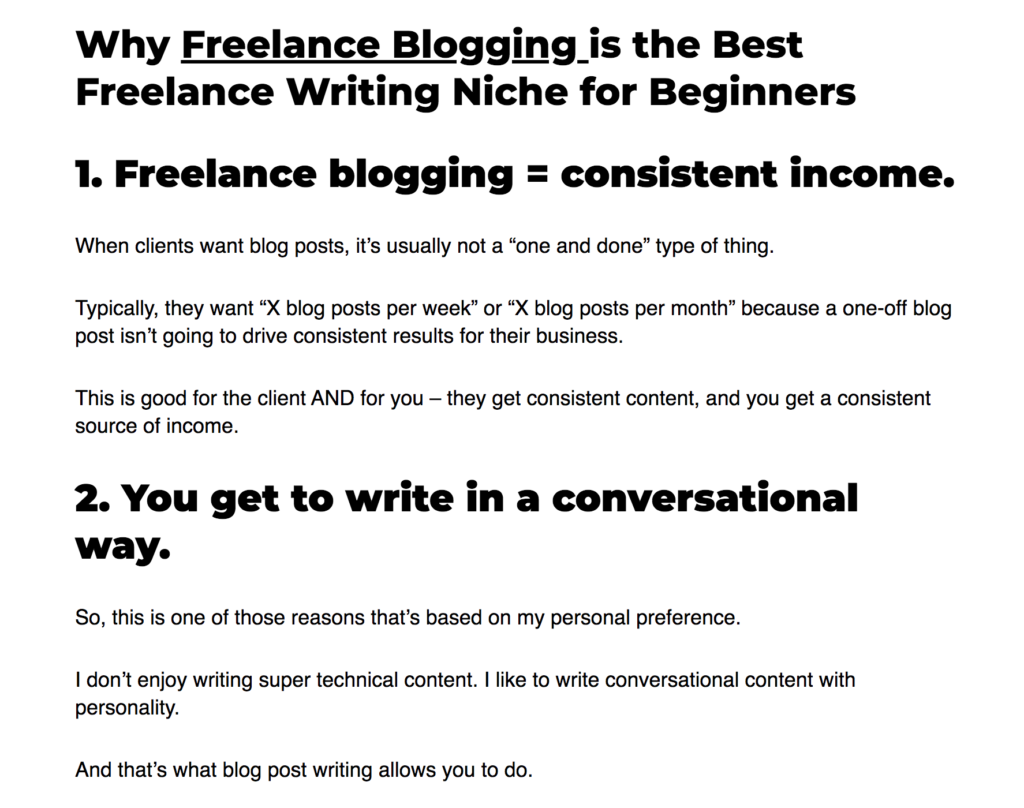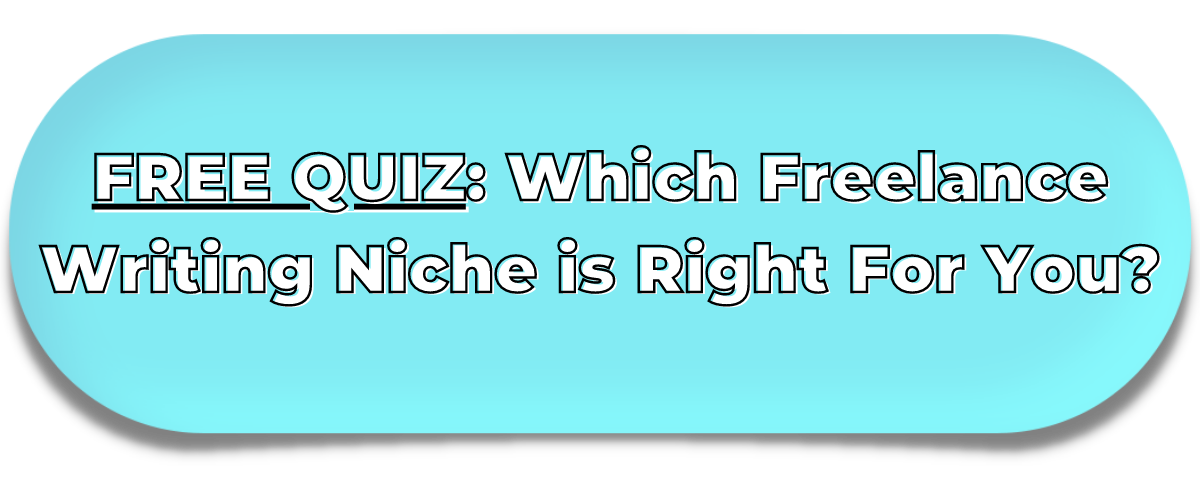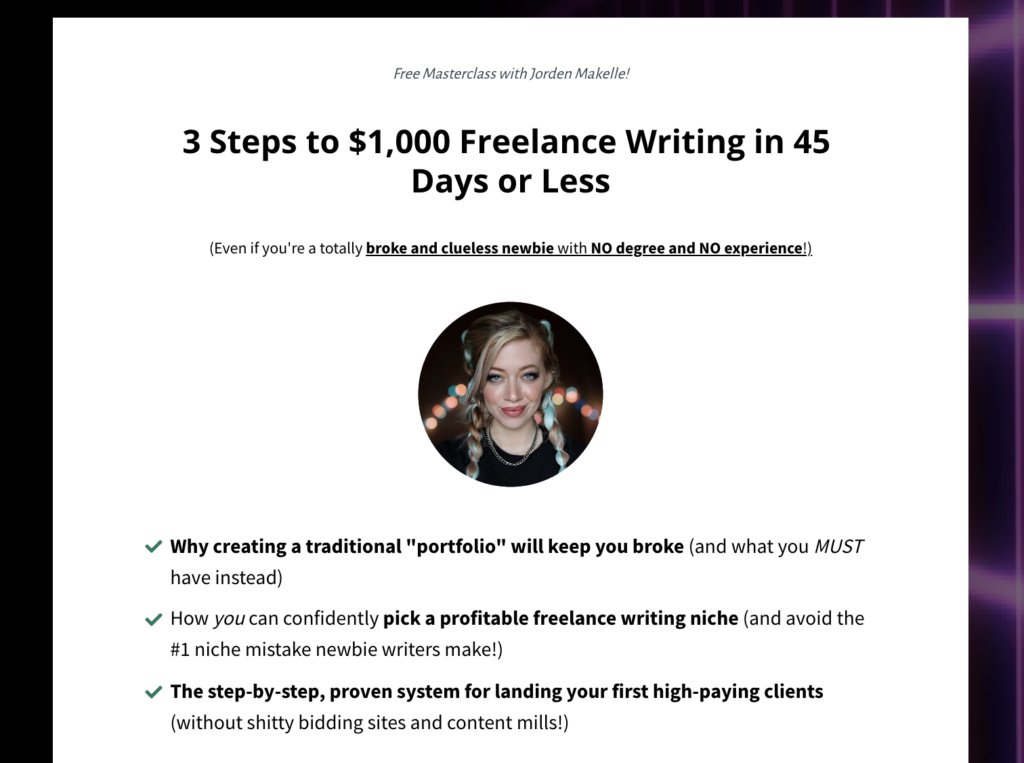I’ve gotta say: learning copywriting – even as a clueless beginner – completely changed my life.
Becoming a freelance copywriter allowed me to make $5K/mo freelance writing within 4 months of losing my job.
And I went on to grow my business even more, eventually traveling full-time – truly living my dream life!
The best part?
I did all this copywriting as an inexperienced college dropout with no degree.
And if you commit to learning copywriting…
You can get incredible copywriting clients, grow your own blog or business, or even land a high-paying full-time copywriting job with little to no experience too!
Today, we’ll cover everything you need to know about copywriting – everything from what copywriting really means to exactly how to do it right!
This is all based on my own experience:
- Growing a successful copywriting business to $5K/mo in 4 months after losing my job
- Writing sales page copy that resulted in multiple six figures in sales, and email funnels with record-breaking conversion rates
- Writing blog posts that went viral and got 5-figure social shares (plus, resulted in loads of leads!)
So, you’re learning from someone who is pretty much always writing – and getting real business results from that writing.
Not telling you this to brag…
Just telling you so you know this blog post is the real deal. 😉
By the time you’re done reading here, you’ll walk away with real copywriting skills you can use every single time you write.
Let’s jump right in, starting with copywriting 101 basics:
Copywriting for Beginners: What is Copywriting? What do Copywriters do?
Before we talk about copywriting techniques and formulas, let’s make sure you understand exactly what copywriting means.
We’ll define copywriting, and we’ll talk about how it compares with content writing (the difference is slight and can be tricky!).
I’ll also share exactly what copywriters do and the types of projects you can expect to take on as a copywriter.
What is copywriting?
A copywriter is someone who writes for advertising and marketing purposes.
In other words, they write with a clear business goal in mind, whether that’s:
- Selling more products
- Getting more leads
- Driving more traffic to a website
…Or something similar!
Just think about it like this:
As a copywriter, you’re essentially a salesperson who sells using the written word instead of actually speaking with the customer.
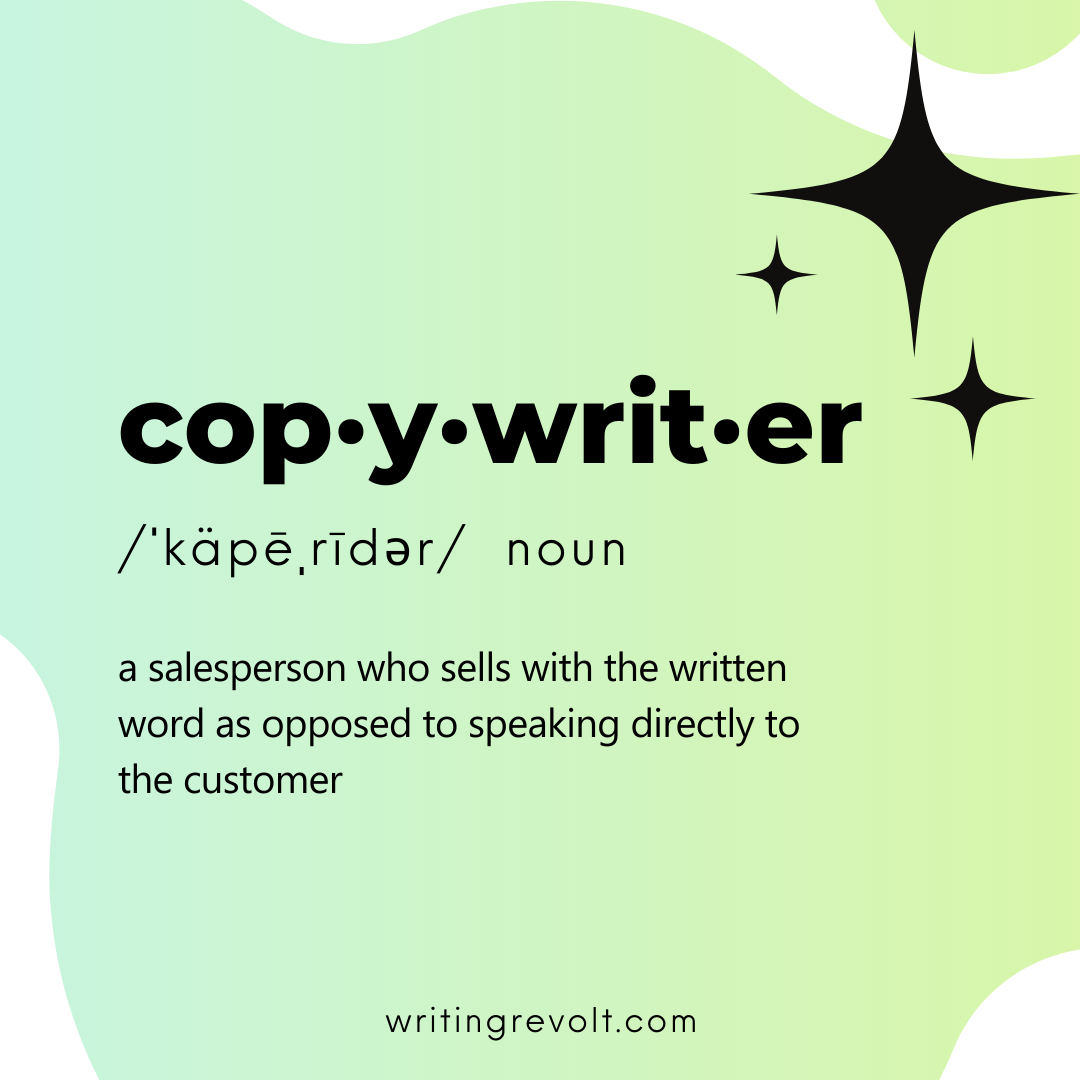
Like a salesperson, you sell by convincing your customer to take action.
Additionally, like a salesperson, you’re also able to convince the customer that what they want is worth it – because of all the features and benefits.
You just have an easier job: sitting in front of your computer instead of talking to people all day long! 🙂
This makes copywriting an ideal career for introverts who enjoy writing.
What do copywriters do?
Copywriters write all different types of content.
Common copywriting projects include:
- Sales pages
- Press releases
- Website conversion copy
- Email newsletters
- Blog posts
- Landing pages
- Case studies
- Whitepapers
Now, if we’re specifically talking about copywriting jobs for beginners…
You’re probably going to be writing lower-stakes content at first, like blog posts.
Blog posts are important pieces of copy, but companies don’t often rely on them to hard sell in high-stakes situations.
The good news?
This makes blog post writing the best niche niche for a beginner freelance copywriter.
As you prove you can drive results with your content, you may more on to higher-stakes copywriting projects, like product launch sales pages where the company relies heavily on your writing to directly sell a product.
Now, keep in mind that copywriters do so much more that just “write words on a page.”
When you land a copywriting job, you’ll also need to think about:
- The product or service being advertised – and what makes it significantly different from the competition.
- Features and benefits of the product or service
- How to convey all of the information in a clearly structured format that keeps the audience engaged
- Who your target market is, and how to write in a way that appeals to them
- How your writing is actually going to lead to more sales for your client
Of course, no one comes out of the womb understanding copywriting (although that would be pretty cool!) or being known as an expert at all of these things.
So, sorry if you thought you’d magically wake up one day with the expertise and guts to start copywriting….
Sorry. It ain’t happenin’. 😉
But what you can do is just start copywriting now and improve as you grow.
Now, I’ve got one more common question to address before we talk about the top 10 techniques you need to learn about and use as a beginner copywriter…
Is copywriting the same as content writing?
Long story short:
Content writing typically involves a softer or indirect sale.
For example:
The “soft sell” in a blog post may involve asking the reader for their email address.
This isn’t a direct sale, but eventually, the the email subscriber may buy a product later on when they see a promotional email.
I’ve found that, when a client says they’re looking for a “content writer,” they’re often talking about someone who writes blog posts.
Or another type of content that sells indirectly rather than directly.
On the other hand, copywriting more often involves a hard sell or selling more directly.
An example of this is an online course sales page, where the copy is hard selling you on enrolling in the course.
If you’ve seen my Killer Cold Emailing sales page, then you know how this works:
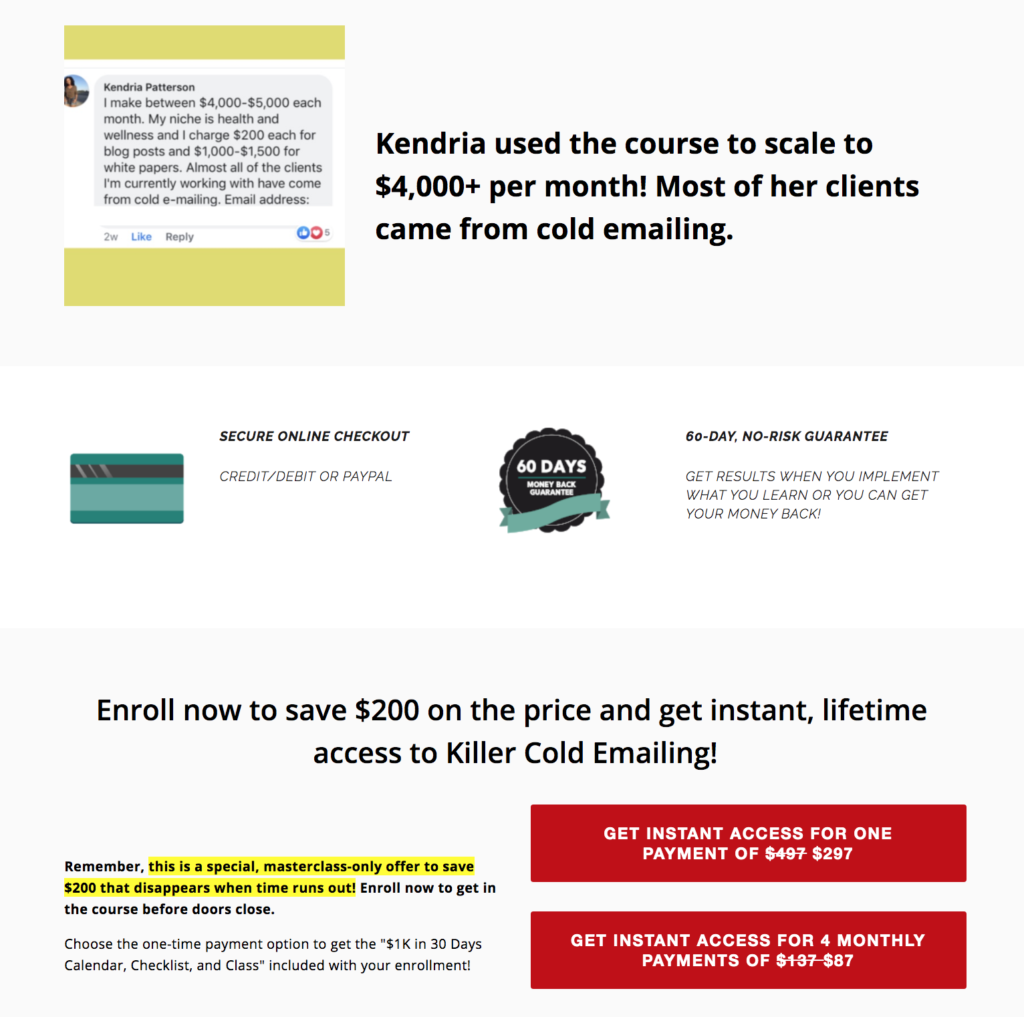
All copy has one goal: to get the reader to take a specific action. A sales page for a product is a perfect example of copywriting with the goal of closing a sale.
No beating around the bush in sales copy – you ask directly for the sale.
Now, I want to be clear:
Writers who focus on content writing must also learn copywriting.
“Words on a page” aren’t enough, even for something like blog post copywriting.
You need to write words that actually impact the client’s business.
So, now that you’re at a point of understanding copywriting basics, like what it is and what copywriters do…
It’s time to dive into the good stuff!
Keep reading, and we’ll talk about the top 10 proven-to-work copywriting techniques and formulas that the pros swear by.
Just think of this blog post as a “Copywriting 101” class. 😉
That way, you can start copywriting ASAP – and maybe even land your first freelance copywriting job!
Copywriting for Beginners: How to Sell With Your Writing Using 10 Key Copywriting Skills
1. Know your target customers, and write directly to them.
Copywriting isn’t about expressing your personality and writing in the way you enjoy most.
It’s about what resonates with the target audience.
So make sure that you’re tailoring your voice to the target audience – always!
This is truly copywriting 101, so make sure you get it down!
For example:
Let’s say you’re writing a blog post with a round-up of the best recipes for college students, so your target audience is the average college student.
With your target audience in mind, you could confidently assume that, within your blog post:
- None of the recipes should use expensive cooking gear, like food processors. College kids rarely have these types of items.
- None of the recipes should require a lot of expensive ingredients. College kids often budget shop.
- The recipes should take into account that college kids are often short on time. Let’s be honest – they’re usually either studying or partying, and cooking isn’t at the top of the priority list!

College students are broke AF. So… get that “food processor” and “$200 worth of ingredients” shit outta here. 🙂
See how that works?
The target audience literally dictates the entire direction of your copywriting.
To take it a step further, you could use pop culture references in the blog post that appeal to college kids, write in a more informal and entertaining tone, or even joke around with something relatable to that specific audience.
Knowing your audience is one of the most important steps you’ll take as a copywriter.
So…
Make sure you do it!
2. Use proven copywriting formulas, like PAS.
Pro copywriters don’t use guesswork to write.
They start with swipe files and proven copywriting formulas, like PAS.
Formulas are truly key to understanding copywriting and doing it right!
So, let’s talk about the PAS formula, a personal fave of mine.
PAS stands for Problem, Agitate, and Solution.
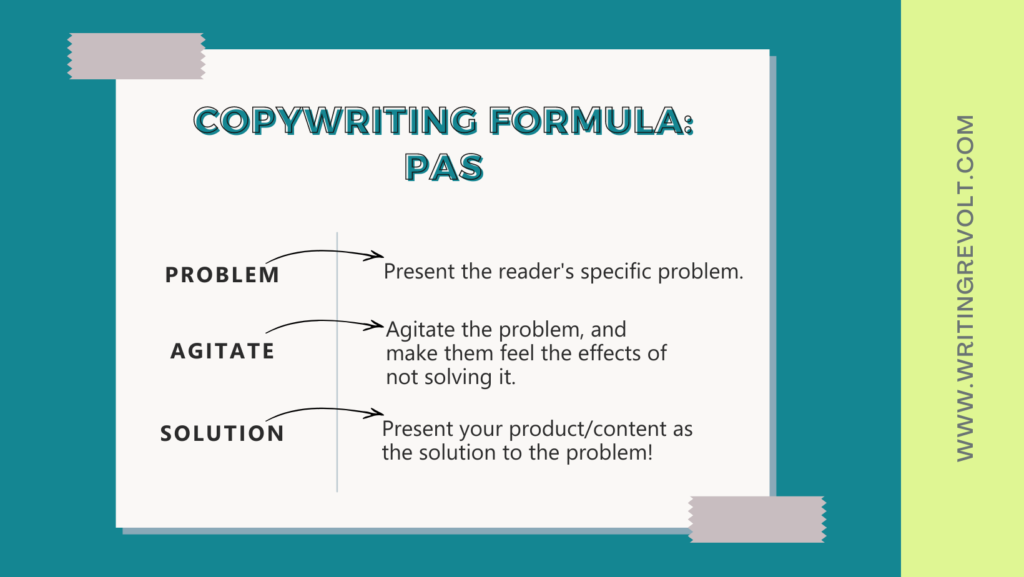
Let’s look at an example of how to use this copywriting formula.
Imagine you’re writing a blog post about Chihuahua potty training, and you want to use PAS in the blog post introduction.
Here’s how it would work:
- Problem: The Chihuahua won’t stop peeing in the house, and it’s driving the owner nuts.
- Agitate: Not only does the Chihuahua cause the owner extra stress and housework – now their house smells bad, maybe to the point where they’re embarrassed to have guests over.
- Solution: “Keep reading this blog post for a proven process to stop the stink, get your sanity back, and ditch the need to constantly clean your carpets, even with a stubborn senior Chihuahua!”
The Problem and Agitate parts in this example aren’t necessarily word-for-word what you’d actually say in the blog post introduction, but you get the picture.

This example was tooooootally not inspired by Tito, my actual 11-year-old Chihuahua. 😉
For blog post introductions, it works like this:
- First, you present the problem the reader is looking to solve.
- Then, you agitate the problem. Ask yourself: “Why is it crucial for them to solve this? What pain is the problem causing them?
- Finally, you hook the reader to keep reading by promising to give them the solution to the problem in your blog post.
You can use the PAS formula in other types of copy too, like sales pages, social media ads, and more.
So, keep it handy for next time you’re getting started with a copywriting job!
3. Write with the end result in mind.
Ask yourself:
“What’s the true purpose of the copy I’m writing?”
The answer will change from job to job, and you need to stay on top of the latest trends in your industry so you can adapt.
But I’ll tell you what almost every type of copywriting shares:
The end result is to sell and make more money for a company.
Period.
Here are a few examples:
- You write a case study for your client. They use the case study as social proof so they can sell more of their services.
- You write a blog post for your client. The post results in more traffic since you’ve used SEO best practices, and they also get a boost to their email list since you’ve included sign-up call-to-action statements in the post. Months later, they launch a new product to that email list, and the sales start rollin’ in!
- You write a sales page for your client. Because of your sales page, the client makes six figures selling their product. They couldn’t have done it without you!
Noticing the common theme here? 😉
You’ve gotta sell.
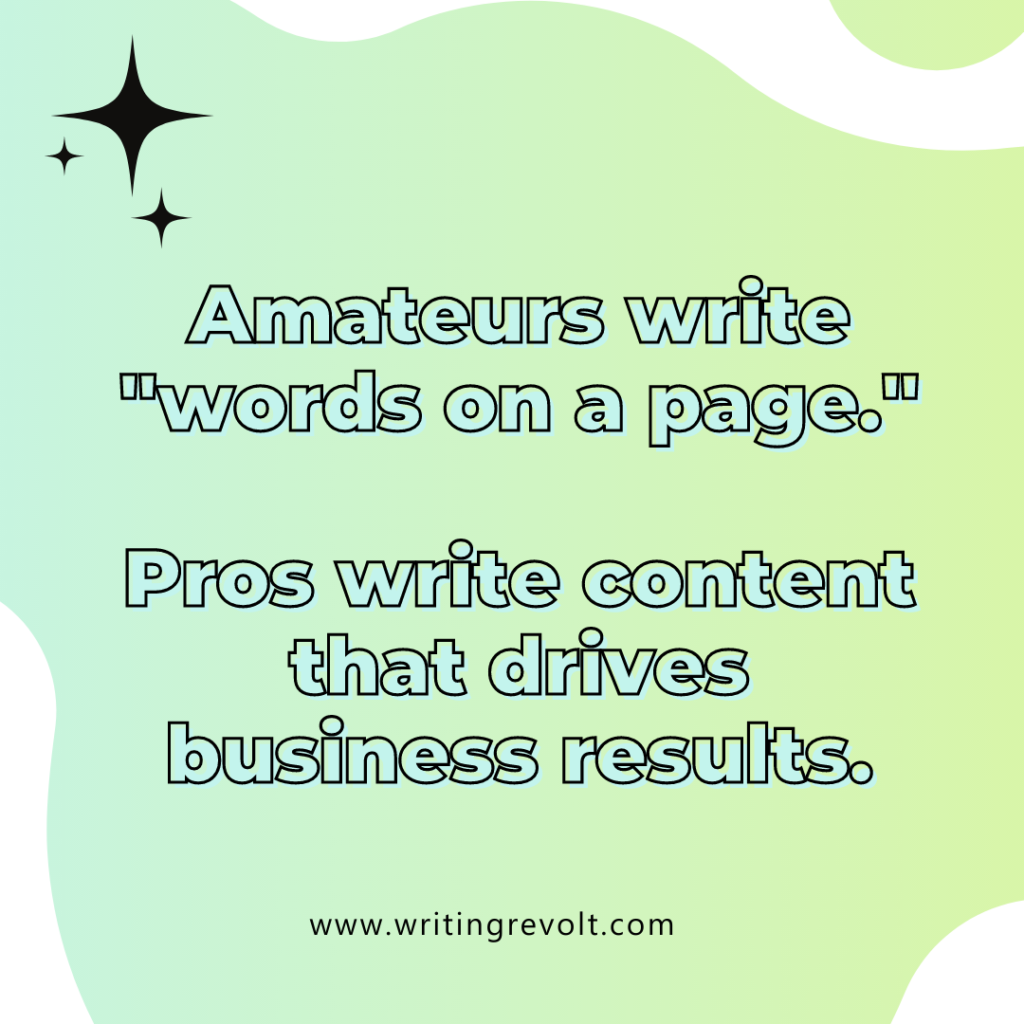
When it comes to copywriting…
Amateurs write “words on a page.”
Pros write strategic content that drives business results.
✨ Related: How to Make Your First $1,000 Freelance Writing in 45 Days – With NO Experience! ✨
4. Speak to the pain points that make the product benefits attractive.
Copywriting for pain points means that you’re speaking directly to the problems that your prospect has.
More specifically – the problems that can be solved with your client’s product.
When you speak directly to the pain points of your target customer, you grab their attention and increase the likelihood of a purchase.
Here’s a common example used in the copywriting world:
“Don’t sell the mattress. Sell the good night’s sleep.”
But…
You need to take that one step further, and talk about why the customer wants a good night’s sleep!
In other words, yes, talk about features and benefits..
And then, talk about why the benefits matter so much, and dig into the specific pain points.
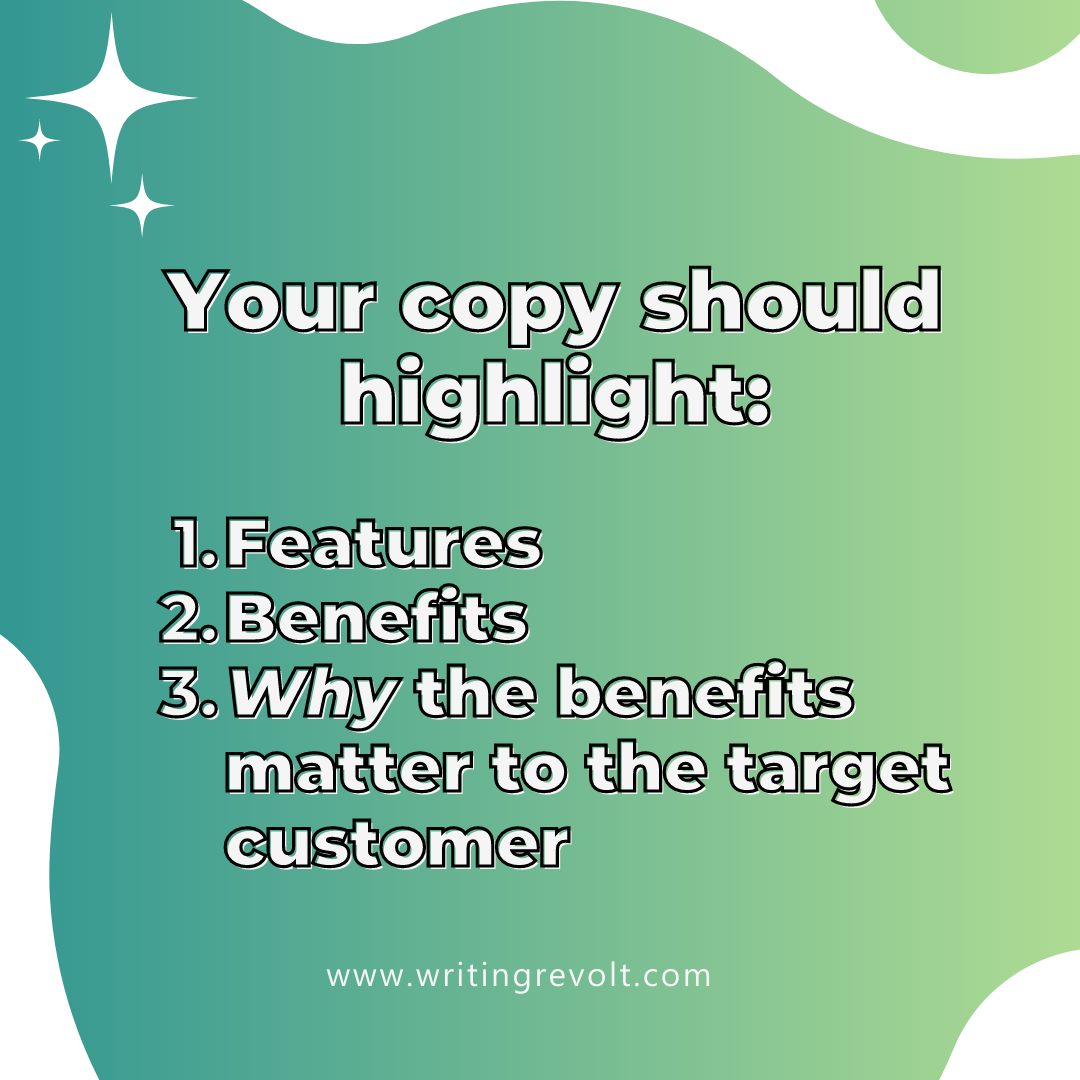
Maybe they want the “good night’s sleep” so:
- They can be less grumpy and therefore have better relationships
- They feel healthier and more productive in general
- They don’t have to rely on coffee as much
See how that works?
This is truly one of the best – and least talked about – tips for beginner copywriters:
Don’t just stop at the first, surface-level problem the product solves.
Dig deeper, and really think about how your audience is affected in their day-to-day life when they don’t solve the problem.
If you can do this effectively, congrats – you’re already doing better than most beginner copywriters.
5. Stick to a middle school reading level!
Ah, yes. The most unpopular copywriting advice among creative writers and those of us who like showing off our big vocabulary. 😉
But it still stands:
You need to write at a middle school reading level.
Before all the novelists and poets out there come at me with pitchforks…
Let me explain:
You need to write copy at a middle school reading level because it’s the level that most of your audience reads comfortably at!
Even if they read at a higher level, remember: people are lazy.
They won’t try to understand your flowery-language-filled sales copy.
They’ll just move on.
What this means is that, if you’re writing above an 8th grade reading level…
Your copy will be harder to understand for the majority.
And just like that, you’ve lost sales.
Bottom line:
Unclear copy kills conversions and sales.
Clarity over creativity.
(I mean, ideally do both, but yeah.)
Now, if you’re all like, “Cool, but how the heck am I supposed to know the reading level of my copy?”
Easy peasy: You use the Hemingway app.
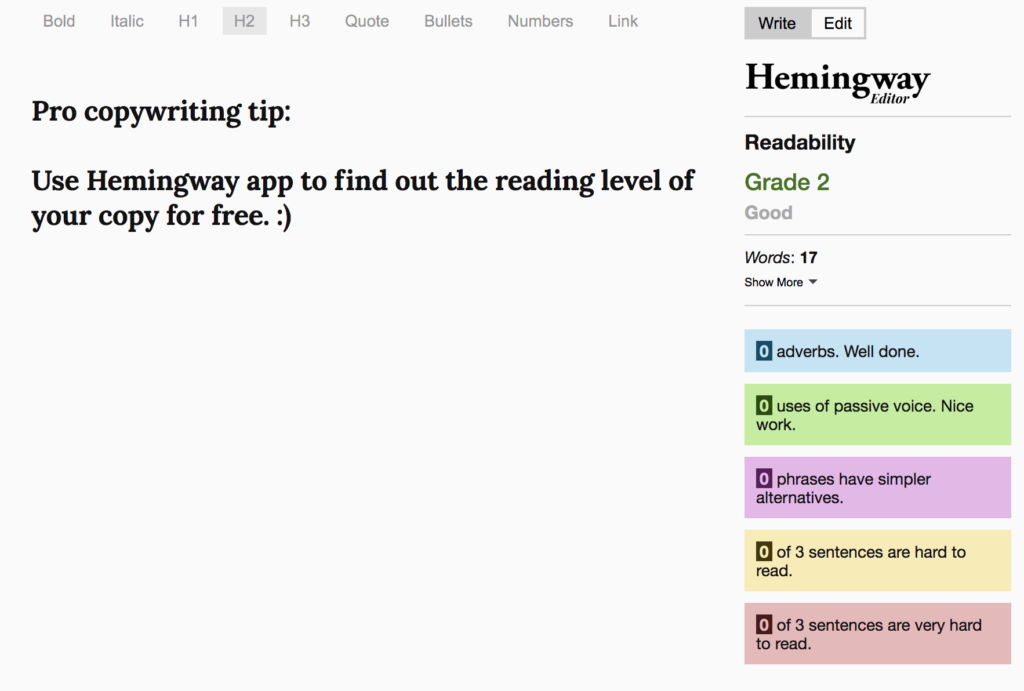
Just pop your copy in, and it’ll tell you what you can do better!
I get that this rule can be painful for newbie copywriters, but remember:
Copywriting isn’t your novel.
It’s not your poetry.
It’s not your songwriting.
This. Is. Copywriting.
…For a business.
Approach it accordingly!
(By the way, I’m a songwriter and creative writer as well, so I get it! But leave your artistic writing to your art, and be about BUSINESS when it comes to your copy.)
6. Lead With Emotion. Then, Prove Your Point.
People decide to buy based on emotion.
Then, they justify that decision with logic and facts.
(^ Stop here. Read those two sentences above again. Then, read ’em again. These are some of the most important things you need to know as a beginner copywriter!)
This means that, in most cases, you need to lead by appealing to emotion in your copy.
Then, after that, you give the reader facts that will help them justify their decision, like social proof, testimonials, and data.
Let’s take a look at an example from Create and Go.
They have a Pinterest course for bloggers, and they use this copywriting technique on their sales page:
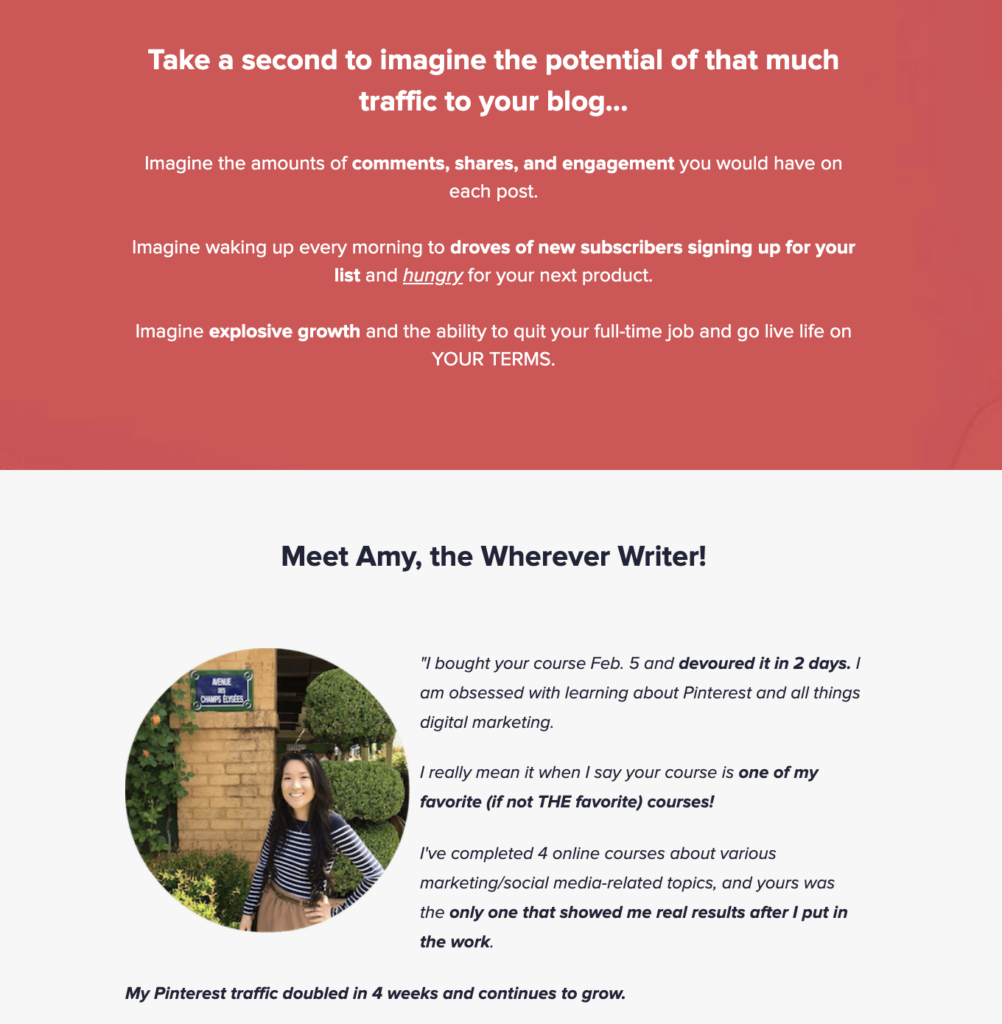
See how that works?
They have the reader imagining getting all the emotional benefits of enrolling, and then, they immediately prove the value of the course with a glowing testimonial.
When you’ve appealed to both emotion and logic in your copy like this –– BOOM!
It’s time to go in for the sale. 🙂
7. Know when to talk benefits vs. when to talk features.
One of the most common pieces of copywriting advice for beginners?
“Talking about benefits is more effective than talking about features.”
But…
- What does that really mean?
- …And is it actually true, like, all of the time?
- …And are there cases where it’s better to focus on features in your copy?
We’ll find out now by comparing benefits vs. features in your copywriting.
When to Focus on Benefits in Your Copy:
Benefits-focused copy can really help you make the sale when your product or service is solving an emotional problem.
Pro tip: Virtually all products solve emotional problems, even if it isn’t obvious at first.
You should use benefit-focused copy heavily if you’re writing for a company that sells things like:
- A weight-loss product: “This vegan diet that will finally help you lose those last stubborn 20 pounds.”
- A self-confidence course applied to dating specifically: “Ask out the person you’ve had a crush on since high school.”
- A book on how to start a side hustle: “How to finally quit the job you hate and work from anywhere in the world!”
Of course, you should still mention features too.
But when the emotional appeal is stronger…
Don’t fight it.
Lead with emotion/benefits.
Then, after that, you can talk features.
When to Focus on Features in Your Copy:
A good example of this would be copywriting for a product management software company.
Think about it:
Project management apps definitely have benefits, and can be tied to real, emotional goals and benefits (simplifying workflow, reducing number of apps used, making work easier, etc.).
But…
Most people shopping around for a project management tool are going to buy based heavily on features and functionality.
So, while it’s still best to lead with emotion, project management software companies need to focus more of their website real estate explaining features and functionality in detail.
Here’s how ClickUp, a project management app, does it on their home page:
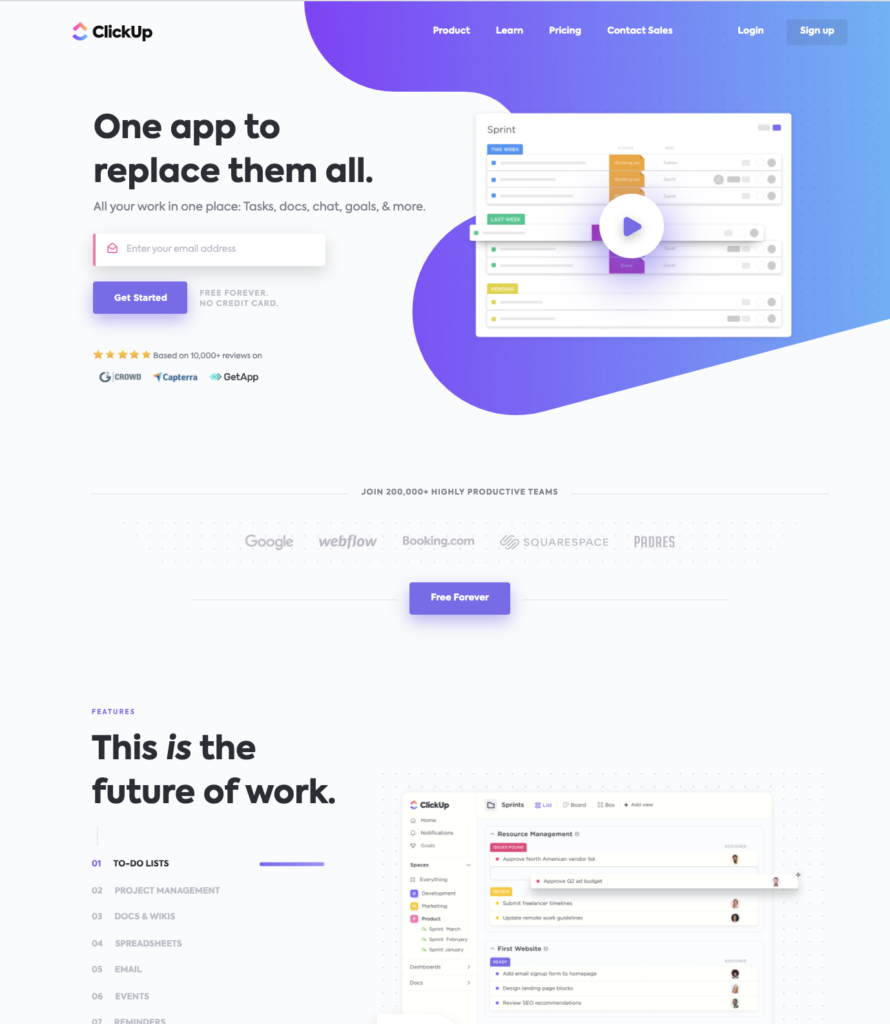
Benefits are the first thing the reader sees, but the rest of the page focuses on features, like to-do lists and spreadsheets!
You can see they lead with the benefit, which is being able to delete all other apps and have a more streamlined workflow… you only need ClickUp.
But right after that?
We see a ton of features, broken down in detail.
In fact, most of their home page is dedicated to showcasing features.
So when you write content for, say, a project management company home page, make sure you highlight the product features heavily.
But remember:
Focusing on features does not mean leading with features.
You still want to lead with the benefits and emotional appeal.
Just make sure you draw lots of attention to the features too if your product is more features-focused.
Don’t hide them away at the bottom of the page or somewhere unnoticeable.
Really, it all comes down to knowing your audience, what’s important to them, and in what order.
Master that, and you’re well on your way to copywriting success.
8. Hook the reader immediately.
A hook is what captures the attention of your reader at the start of your copy and convinces them to continue reading.
Fail to hook the reader?
…Then they’ll be on to the next thing, and you’ll lose out on an opportunity to make the sale.
You lose. Your client loses.
Everybody loses.
Doesn’t matter what kind of copy you’re writing – sales pages, Facebook ads, and even blog posts need a good hook.
Let’s look at an example of how to hook the reader.
I used a few “hook” techniques in the intro of this blog post about how to start freelance writing as a beginner.
Here are a few “hook” techniques I used in the copy above:
- Showing proof: I shared that I made $5K/mo in 4 months after starting out as a full-time freelance writer.
- Speaking directly to the reader: I use “you” a lot and – GASP – I even swear in my copy! This doesn’t work for everyone, but it works for me because it’s just how I talk, so it’s more natural. 😉
- Overcoming objections: Many of my readers are aspiring freelance writers, and they have a lot of fears and doubts about what they can achieve. So, I reassure them and back up my statements with the fact that I quickly made $5,000/mo, even as a beginner, and I never had to use content mills to do so.
By the way…
You can learn my entire blog post copywriting process right here inside my F Yeah Freelance Blogging course. 😉
Or:
Start out with my free masterclass on how to get paid $200-$400+ per blog post as a beginner freelance writer right here.
9. Ditch the boring jargon.
I’m just gonna say it:
Using jargon is a clear sign of an amateur copywriter.
And let me tell you:
If you use boring jargon in your writing, your readers will either:
A) ✅ Misunderstand you, and therefore move on to your competitor
Or…
B) ✅ Get mind-numbingly bored, and therefore move on to your competitor
Either way…
You lose the sale.
Instead of using boring jargon, write how you talk.
And write your copy at about a middle school reading level.
Here’s an example:
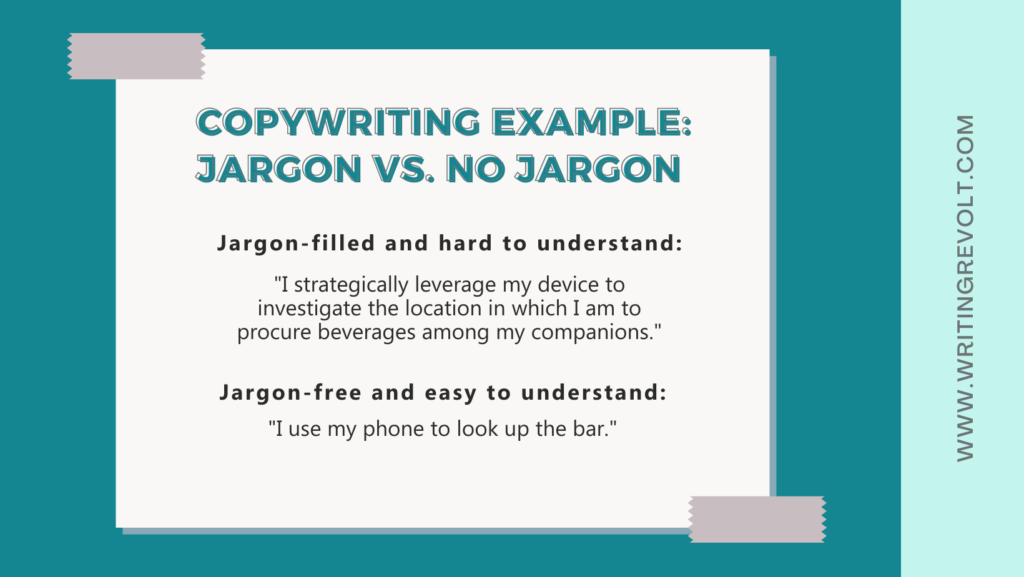
See how that works?
The jargon-free version is so much clearer – and quicker/easier to read.
(And frankly, about 10,000x less pretentious, lol.)
Jargon. Ditch it.
(And yes, this applies to tech-y companies too! Even tech-y people are humans, so don’t talk to them like they’re robots, k?)
10. Use the top copywriting tools the pros swear by.
Oh man, I love a good copywriting tool.
I’ve got a list of my favorite freelance writing tools right here, but as far as copywriting for beginners, start with these 3:
- Hemingway App offers sentence and word level editing. Plus, you get a readability score, which is an estimate of how difficult it will be for readers to understand what you’ve written. This app will identify passive voice, adverbs, long sentences, complicated words or phrases, and much more.
- Google Docs is the best way to send your work to client, and what most clients prefer to use. Plus, it’s free. Score.
- SEMRush (affiliate link) is my SEO tool of choice and something I use all the damn time. It’s truly incredible and makes me feel like I have magical frickin’ powers! You probably don’t need this if you’re, say, a beginner blog post copywriter, but if you do high-level SEO strategy for clients, then SEMRush it’s an excellent choice and can quickly pay for itself! I couldn’t be happier with it.
I’m actually working on a post full of my favorite copywriting tools, and I’d love to hear all about yours.
Seriously – leave me a comment below, and tell me your fave copywriting tools. I love hearing from you!
Now that you’ve mastered copywriting for beginners, it’s time to take bold action!
Looking to land your first beginner copywriting job?
Want to become a freelance writer so you can have financial freedom… or maybe even travel full-time?
The worst thing you can do is hold yourself back from taking action due to fear.
Let me be clear:
You can make an incredible, full-time living freelance copywriting, even if you’re inexperienced and have no college degree (I’m living proof!)
Start now by joining over 13,000 writers in my top free masterclass 👇👇👇👇
How to Make Your First $1,000 Freelance Writing in 45 Days or Less – Even With ZERO Experience
You get instant access when you join the class…
Meaning you’re just seconds away from learning something that could change your career – and your entire life!
And then…
Get out there and get your first copywriting job. You’ve earned it. 🙂
Do you have any questions about these beginner copywriting tips? I love hearing from you, so comment below!


